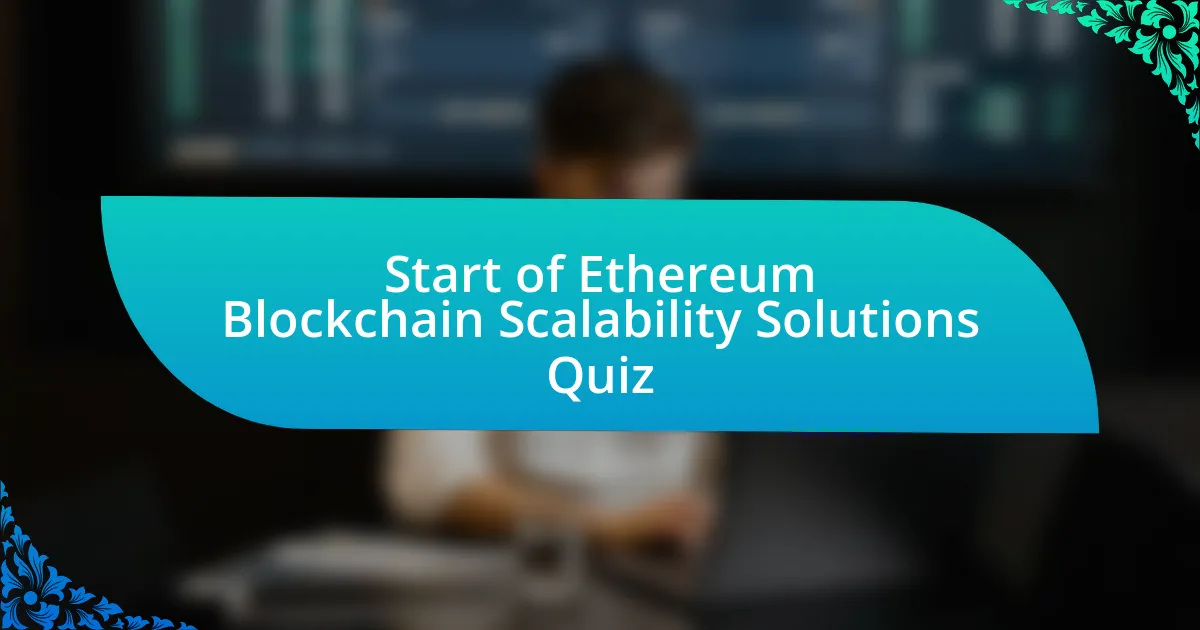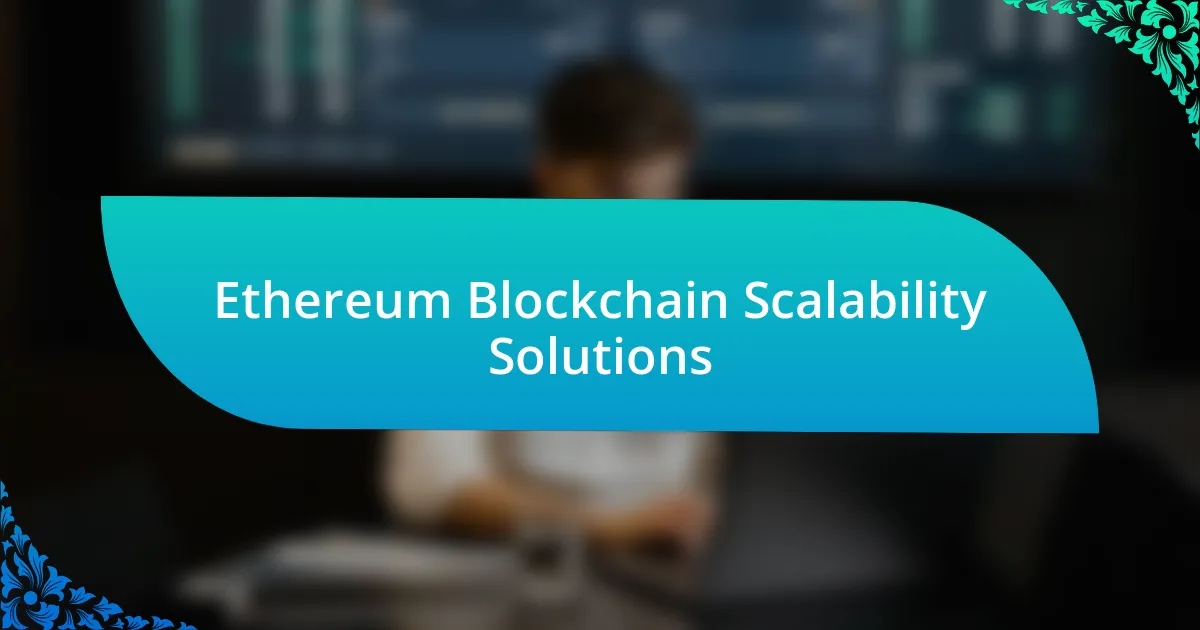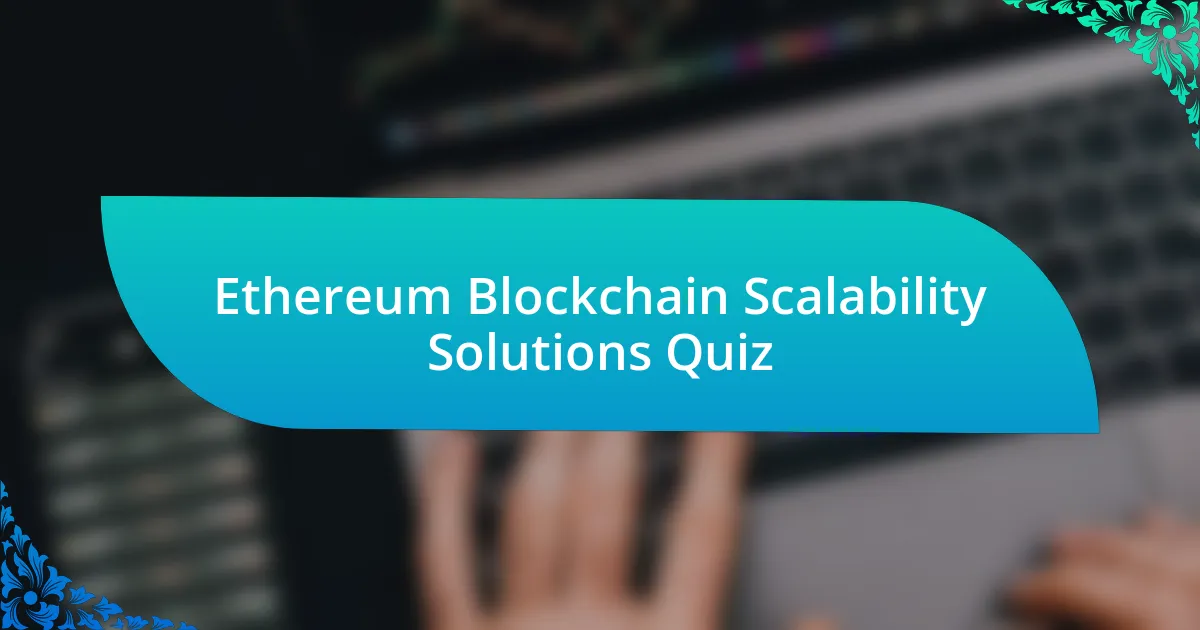
Start of Ethereum Blockchain Scalability Solutions Quiz
1. What is the main scalability issue facing Ethereum?
- Limited transaction throughput
- High transaction fees
- Lack of decentralization
- Insufficient smart contract support
2. What are Layer 2 solutions for Ethereum?
- Layer 2 solutions are independent blockchains without any connection to Ethereum.
- Layer 2 solutions involve restructuring the Ethereum consensus mechanism entirely.
- Layer 2 solutions are protocols or techniques built on the Ethereum blockchain to enhance scalability.
- Layer 2 solutions serve solely for storing metadata related to transactions.
3. Which Layer 2 solutions can be used in conjunction with Ethereum 2.0?
- Ethereum Classic
- Ripple
- Optimism
- Cardano
4. What is Ethereum 2.0?
- Ethereum 2.0 is a new cryptocurrency separate from Ethereum.
- Ethereum 2.0 is a decentralized exchange platform.
- Ethereum 2.0 is a major upgrade to improve scalability, security, and sustainability.
- Ethereum 2.0 is solely focused on enabling NFT transactions.
5. How do Layer 2 solutions improve Ethereum’s scalability?
- Layer 2 solutions enhance Ethereum by consolidating all transactions into a single block, making it harder to verify.
- Layer 2 solutions improve Ethereum’s scalability by handling transactions off the main chain, reducing the load on Ethereum, and leading to faster transactions and lower fees.
- Layer 2 solutions slow down the network by processing all transactions on-chain, increasing congestion and fees.
- Layer 2 solutions do not affect Ethereum`s scalability as they operate independently of the main Ethereum chain.
6. What is the role of sharding in Ethereum 2.0?
- Sharding reduces network fees by eliminating transactions.
- Sharding helps process transactions in parallel, increasing throughput.
- Sharding stores all data on a single block to simplify processing.
- Sharding consolidates all transactions to a single ledger for efficiency.
7. What is the difference between Bitcoin and Ethereum blockchains?
- Bitcoin offers a decentralized ledger, while Ethereum provides a programmable blockchain with smart contracts.
- Bitcoin focuses solely on digital currency, while Ethereum is just for NFTs.
- Bitcoin allows for smart contracts, while Ethereum does not support them.
- Both Bitcoin and Ethereum use the same consensus algorithm to validate transactions.
8. What is the primary purpose of ETH layer-2 scaling solutions?
- Decrease security and increase transaction size significantly.
- Improve aesthetic appeal of smart contracts and dApps.
- Enforce centralization of validation and transaction processing.
- Increase throughput and reduce fees by processing off-chain.
9. How does Arbitrum work?
- Arbitrum functions by creating a separate blockchain that operates independently of the Ethereum network.
- Arbitrum uses optimistic rollups, executing transactions off-chain before bundling them into large batches, which are submitted to the Ethereum mainnet as calldata.
- Arbitrum relies solely on state channels for executing transactions without affecting the main blockchain.
- Arbitrum processes all transactions directly on the Ethereum mainnet to ensure maximum security and speed.
10. What is the benefit of using optimistic rollups in Arbitrum?
- Requires complete transaction validation on-chain.
- Reduces gas fees and optimizes block space.
- Eliminates the need for smart contracts.
- Increases transaction speed on the main chain.
11. What is the role of state channels in Layer 2 solutions?
- State channels require each transaction to be confirmed on-chain.
- State channels eliminate the need for a decentralized network.
- State channels slow down the transaction process on the main chain.
- State channels enable multiple transactions without updating the blockchain.
12. What is the difference between on-chain and off-chain data storage in Volition?
- Volition requires off-chain storage for all transactions.
- Volition allows users to choose on-chain or off-chain storage.
- Volition uses only centralized servers for data.
- Volition stores all data on-chain for security.
13. What is Validium?
- Validium is a storage protocol designed only for private transactions.
- Validium is a consensus algorithm for block verification.
- Validium is a hybrid solution that optimizes data availability by storing transaction data off-chain.
- Validium is a token used for transaction fees on Ethereum.
14. How do cross-chain solutions enhance Ethereum’s scalability?
- Cross-chain solutions only allow transferring of Ethereum tokens between wallets.
- Cross-chain solutions limit transactions to a single network for better efficiency.
- Cross-chain solutions enhance Ethereum by increasing its gas fees significantly.
- Cross-chain solutions distribute the transaction load across multiple networks.
15. What is the benefit of combining Layer 2 techniques with Ethereum 2.0 features?
- It provides a completely private transaction environment.
- It eliminates the need for smart contracts entirely.
- Combining Layer 2 techniques with Ethereum 2.0 can increase transaction efficiency.
- It guarantees zero gas fees for all transactions.
16. What is the average block size in Ethereum?
- 512 MB
- 4 KB
- 2 KB
- 1 MB
17. What is the block time in Ethereum?
- 20 seconds
- 30 seconds
- 10 seconds
- 14 seconds
18. Can transactions be kept hidden on the public Ethereum network?
- No, transactions are private but can be requested.
- No, all transactions on the public Ethereum network are public.
- Yes, transactions can be completely anonymized on Ethereum.
- Yes, transactions are only visible to selected users.
19. Is the user’s private key used to sign transactions?
- Yes, but only for public transactions.
- No, only the user’s public key is used for signing.
- Yes, the user’s private key is used to sign transactions.
- No, the user’s private key is not necessary.
20. What happens when gas runs out without the transaction being complete?
- The transaction is processed with a higher gas fee.
- The gas fees are refunded to the user later.
- The transaction fails and the user loses their gas fees.
- The transaction completes but without confirmation.
21. What is Truffle?
- Truffle is a new cryptocurrency for trading.
- Truffle is a social media networking tool.
- Truffle is a database management software.
- Truffle is a popular testing and development environment for Ethereum.
22. What is Remix?
- Remix is an online tool used to deploy, test, and develop smart contracts.
- Remix is a hardware device for mining cryptocurrencies.
- Remix is a cryptocurrency wallet for storing Ethereum.
- Remix is a social media platform for blockchain developers.
23. How does Ethereum check the latest state for account balances?
- Ethereum relies on third-party APIs to check balances.
- Ethereum checks the latest state for account balances.
- Ethereum uses external servers for account balances.
- Ethereum manually updates account balances through transactions.
24. How does Bitcoin check the latest state for unspent transaction outputs (UTXO)?
- Bitcoin counts the number of transactions.
- Bitcoin verifies the block headers.
- Bitcoin checks the UTXO set.
- Bitcoin computes the SHA-256 hash.
25. What is the main programming language used to write smart contracts and dApps on Ethereum?
- Solidity
- JavaScript
- C++
- Python
26. What is MetaMask?
- MetaMask is a programming language for developing smart contracts.
- MetaMask is a popular browser-based Ethereum wallet used to interact with dApps on the Ethereum network.
- MetaMask is a decentralized exchange for trading cryptocurrencies.
- MetaMask is a cryptocurrency mining software for Ethereum.
27. What are some common consensus algorithms used in blockchain technology?
- Proof-of-Measurement (PoM)
- Proof-of-Simulation (PoS)
- Proof-of-Commitment (PoC)
- Proof-of-Work (PoW)
28. Which consensus algorithm does Ethereum currently use?
- Proof-of-Work (PoW)
- Proof-of-Stake (PoS)
- Byzantine Fault Tolerance (BFT)
- Delegated Proof-of-Stake (DPoS)
29. What is the primary use case for smart contracts in real estate?
- Smart contracts can be used in real estate to set up a contract that transfers property once the buyer transfers the property amount.
- Smart contracts are mainly used to develop video games that simulate real estate trading.
- Smart contracts provide a platform for social media interactions and user engagement in real estate.
- Smart contracts primarily serve as a method for financing real estate investments through traditional banks.
30. How do hybrid solutions like Validium and Volition enhance Ethereum’s scalability?
- Hybrid solutions enhance Ethereum by suppressing gas fees without changing data storage methods.
- Hybrid solutions solely focus on making Ethereum 2.0 compatible with existing wallets.
- Hybrid solutions like Validium and Volition enhance Ethereum’s scalability by leveraging the advantages of rollups while optimizing data availability or offering flexibility in data storage.
- Hybrid solutions increase Ethereum`s speed by using only on-chain data for all transactions.

Quiz Successfully Completed!
Congratulations on completing the quiz on Ethereum Blockchain Scalability Solutions! This journey not only tested your knowledge but also helped you discover the various strategies being implemented to enhance Ethereum’s performance. From Layer 2 solutions to sharding, you’ve explored key concepts critical for understanding the blockchain’s evolution.
Through this quiz, you’ve likely gained insights into the challenges Ethereum faces regarding scalability and the innovative ways developers are addressing these issues. The need for faster transaction speeds and reduced costs is paramount. You’ve also learned how these solutions can make decentralized applications more efficient and user-friendly.
To deepen your understanding, we invite you to check out the next section on this page. It contains a wealth of information on Ethereum Blockchain Scalability Solutions. Here, you can find detailed explanations, case studies, and the latest developments in the field. Continue your learning journey and stay updated with the ever-evolving world of blockchain technology!

Ethereum Blockchain Scalability Solutions
Understanding Ethereum Blockchain Scalability Issues
Ethereum’s scalability issues stem from its limited transaction throughput. The network can process approximately 15 transactions per second (TPS), leading to congestion and high gas fees during peak usage periods. This limitation affects user experience and application performance, restricting Ethereum’s capacity to accommodate widespread adoption.
Layer 2 Solutions for Ethereum Scalability
Layer 2 solutions operate on top of the Ethereum blockchain to enhance scalability. They reduce the load on the main chain by processing transactions off-chain while maintaining security through the main chain. Popular Layer 2 solutions include Optimistic Rollups and zk-Rollups, which significantly increase throughput and lower transaction costs.
Sharding as a Scalability Solution
Sharding involves dividing the Ethereum network into smaller partitions, or “shards.” Each shard processes transactions independently, allowing for parallel processing. This approach aims to significantly increase the overall capacity of the Ethereum network, enabling it to handle a larger volume of transactions simultaneously.
The Role of Proof of Stake in Ethereum Scalability
Ethereum’s transition from Proof of Work (PoW) to Proof of Stake (PoS), known as Ethereum 2.0, impacts scalability by improving transaction validation efficiency. PoS enables faster block times and requires less computational power, resulting in decreased energy consumption and increased transaction throughput, thus addressing scalability challenges.
Interoperability and Cross-Chain Solutions for Enhanced Scalability
Interoperability initiatives facilitate communication between Ethereum and other blockchains. Cross-chain solutions, like bridges, enable the transfer of assets across different networks. This interconnectedness can relieve some pressure from the Ethereum network, distributing the transaction load and enhancing overall scalability.
What are Ethereum Blockchain Scalability Solutions?
Ethereum Blockchain Scalability Solutions refer to various methods implemented to enhance the transaction speed and capacity on the Ethereum network. These solutions aim to enable the network to handle more transactions per second (TPS) while reducing fees and improving overall user experience. Examples include Layer 2 solutions like Rollups and sidechains, as well as sharding, which splits the blockchain into smaller pieces to process transactions simultaneously. According to the Ethereum Foundation, these approaches can significantly improve network efficiency and reduce congestion.
How do Layer 2 Solutions improve Ethereum Blockchain scalability?
Layer 2 Solutions improve Ethereum Blockchain scalability by processing transactions off the main Ethereum chain while still relying on its security. Transactions are bundled and settled on the Layer 2 network, which reduces the load on the Ethereum mainnet. Rollups are a prominent example, where multiple transactions are aggregated and submitted as a single transaction on the main chain. A report by ConsenSys estimates that rollups can increase Ethereum’s throughput to over 100,000 TPS, thus significantly enhancing scalability.
Where are the primary implementations of Ethereum scalability solutions occurring?
The primary implementations of Ethereum scalability solutions are occurring in decentralized finance (DeFi) applications, non-fungible tokens (NFTs), and gaming platforms. These sectors require high transaction throughput and low latency, making scalability solutions critical. Platforms like Polygon and Optimism have become popular Layer 2 solutions that integrate with various DeFi and NFT projects on Ethereum. As of 2023, over 1,500 projects are reported to be utilizing these Layer 2 scaling solutions, indicating widespread adoption.
When are Ethereum scalability solutions expected to reach full effectiveness?
Ethereum scalability solutions are expected to reach full effectiveness with the completion of Ethereum 2.0, specifically post the implementation of sharding and other enhancements. These upgrades are anticipated to be fully rolled out by 2024. The Ethereum Foundation has indicated that by combining these solutions with current Layer 2 technologies, scalability can potentially reach beyond 100,000 TPS, addressing the network’s congestion issues. The transition has been outlined in Ethereum’s roadmap since the launch of its Beacon Chain in December 2020.
Who is responsible for developing Ethereum scalability solutions?
Various teams and organizations are responsible for developing Ethereum scalability solutions, including the Ethereum Foundation, development teams of Layer 2 projects like Optimism and Polygon, and independent developers in the Ethereum community. The Ethereum Foundation provides core protocol support and funding for these initiatives. Research and development efforts are often collaborative, involving multiple stakeholders and contributions from various open-source communities. Key individuals like Vitalik Buterin have also played significant roles in promoting and conceptualizing these scalability approaches.

